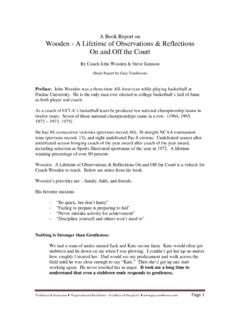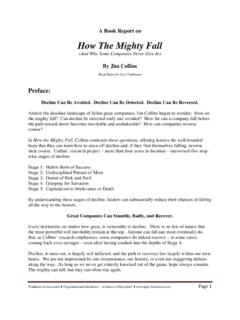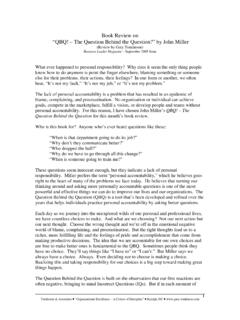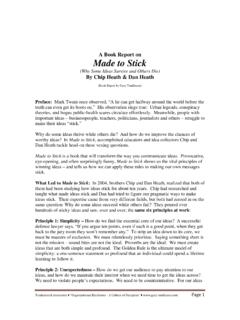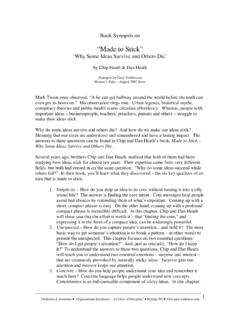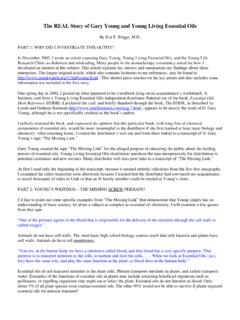Transcription of How Full is Your Bucket? - Gary E Tomlinson's …
1 Tomlinson & Associates Organizational Excellence A Culture of Discipline Page 1 A Book Report on How full is your bucket ? By Tom Rath & Donald Clifton, (Book Report by gary Tomlinson) Introduction: In the early fifties, Don Clifton, was teaching psychology at the University of Nebraska when he noticed a major problem: The field of psychology was based almost entirely on the study of what is wrong with people. He began to wonder if it would be more important to study what is right with people.
2 So, over the next five decades, Don and his colleagues conducted millions of interviews, focusing on the positive instead of the negative. Early in his research, Don discovered that our lives are shaped by our interactions with others. Whether we have a long conversation with a friend or simply place an order at a restaurant, every interaction makes a difference. The results of our encounters are rarely neutral; they almost always positive or negative. And although we take these interactions for granted, they accumulate and profoundly affect our lives.
3 Based on a simple metaphor of a dipper and a bucket Don s theory carried profound implications and simplified his life s work for others. How full is your bucket contains the most compelling discovers Don had gathered over half a century of work in his field of Positive Psychology. The Theory of the Dipper and the bucket : Each of us has an invisible bucket . It is constantly emptied or filled, depending on what others say or do to us. When our bucket is full , we feel great. When it s empty, we feel awful.
4 Each of us also has an invisible dipper. When we use that dipper to fill other people s buckets by saying or doing things to increase their positive emotions we also fill our own bucket . But when we use that dipper to dip from others buckets by saying or doing things that decrease their positive emotions we diminish ourselves. Like the cup that runneth over, a full bucket gives us a positive outlook and renewed energy. Every drop in that bucket makes us stronger and more optimistic. Tomlinson & Associates Organizational Excellence A Culture of Discipline Page 2 But an empty bucket poisons our outlook, saps our energy, and undermines our will.
5 That s why every time someone dips from our bucket , it hurts us. So we face a choice every moment of every day. We can fill one another s buckets, or we can dip from them. It s an important choice one that profoundly influences our relationships, productivity, health, and happiness. Negativity Kills: Don Clifton began studying what is right with people after his review of one specific case study. This study was about as far as possible from a positive or inspiring story. Following the Korean War, Major (Dr.)
6 William E. Mayer, who would later become the Army s chief psychiatrist, studied 1,000 American prisoners of war who had been detained in a North Korean camp. He was particularly interested in examining one of the most extremely and perversely effective cases of psychological warfare on record one that had a devastating impact on its subjects. American soldiers had been detained in camps that were not considered especially cruel or unusual by conventional standards. The captives had adequate food, water, and shelter.
7 They weren t subjected to common physical torture tactics. In fact, fewer cases of physical abuse were reported in the North Korean POW camps than in prison camps from any other major military conflict throughout history. Why, then, did so many American soldiers die in these camps? They weren t hemmed in with barbed wire. Armed guards didn t surround the camps. Yet no soldier ever tried to escape. Furthermore, these men regularly broke rank and turned against each other, sometimes forming close relationships with their North Korean captors.
8 When the survivors were released to a Red Cross group in Japan, they were given the chance to phone loved ones to let them know they were alive. Very few bothered to make the call. Upon returning home, these soldiers maintained no friendships or relationships with each other. Mayer had discovered a new disease in the POW Camps a disease of extreme hopelessness. It was not uncommon for a soldier to wander into his hut and look despairingly about, deciding there was no use in trying to participate in his own survival.
9 He would go into a corner alone, sit down, and pull a blanket over his head. And he would be dead within two days. Tomlinson & Associates Organizational Excellence A Culture of Discipline Page 3 The soldiers actually called it give-up-it is. The doctors labeled it mirasmus, meaning a lack of resistance, a passivity. If the soldiers had been hit, spat upon, or slapped, they would have become angry. Their anger would have given them the motivation to survive. But in the absence of motivation, they simply died, even though there was no medical justification for their deaths.
10 Despite relatively minimal physical torture, mirasmus raised the overall death rate in the North Korean POW camps to an incredible 38% - the highest POW death rate in military history. Even more astounding was that half of these soldiers died simply because they had given up. They had completely surrendered, both mentally and physically. How could this have happened? The answers were found in the extreme mental tactics that the North Korean captors used. They employed what Mayer described as the ultimate weapon of war.
